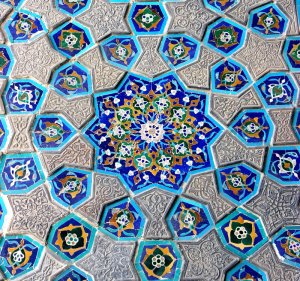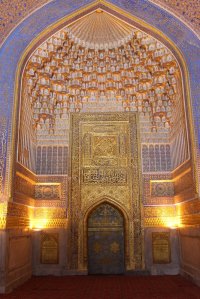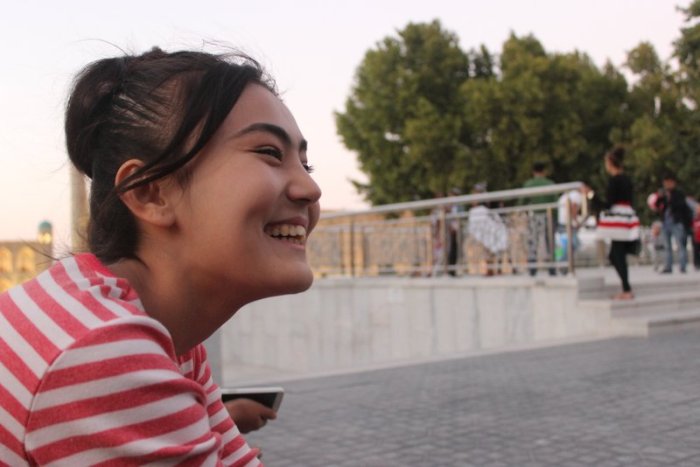The Registan Square in Samarqand is the city’s, and perhaps Uzbekistan’s, most recognised monument. In a way, it is to Uzbekistan what the Taj Mahal is to India. So it was not surprising that the Registan Square was the one place I was looking forward to visiting the most even before I set out for the trip in September 2015. 🙂
It was early evening when I arrived in Samarqand after a beautiful drive through the Zarafshan mountains from Shakhrisabz. As the car drove through the city towards the B&B I would be staying in, my first impressions were of an elegant and beautiful city filled with monuments. I kept an eye out for the Registan Square and even thought I glimpsed it, but could not be sure as the one way roads made me feel like we were going around in circles !
Once at the B&B, I was delighted to find from the very handy map given there that the Registan Square was just a 5-minute walk away. So after freshening up and some tea, I followed the directions on the map and within minutes was at the Registan Square. The sun had almost set and my first glimpse of the iconic monument complex was at twilight.
Time stopped still as I took in the magnificent sight before me and I think I had tears in my eyes as well. Over the next 2 days that I was at Samarqand, I would visit the Registan Square often, and each time it would be an overwhelming experience.
The word Registan means “sandy place” in the Tajik language. Though the location of the complex was an important crossroad along the Silk Route, the actual beginnings of the square goes back to the 9th century CE when a tomb was built for Saint Muhammad ibn Djafar. By 14th century CE, the area was the commercial heart of the town with a bustling market and trading centre, with a road connecting it to Amir Timur’s citadel.
Today, neither Timur’s citadel nor the market or the trading centre survive. The Registan Square Complex comprises three madrassahs built around a vast square between the 15th to the 17th centuries. Over the centuries, the madrassahs fell into disrepair due to frequent earthquakes in the region. But today due to the craftsmanship of the original builders and the Soviets who renovated and restored it to stunning results, the three madrassahs are among the world’s oldest preserved monuments and a UNESCO World Heritage Site.

 The Ulugh Beg Madrassah is the oldest of the three madrassahs at the Registan Square and it was built between 1417–20. Ulugh Beg, Timur’s grandson, was an astronomer and mathematician and both these interests are reflected in the mosaic tile work with depictions of the sky and stars on the entrance arch.
The Ulugh Beg Madrassah is the oldest of the three madrassahs at the Registan Square and it was built between 1417–20. Ulugh Beg, Timur’s grandson, was an astronomer and mathematician and both these interests are reflected in the mosaic tile work with depictions of the sky and stars on the entrance arch.
Built around a large, open courtyard with 50 cells, it is believed that around 100 students stayed at the madrassah and Ulugh Beg himself taught mathematics there.
 The central madrassah is the Tilla Kori Madrassah, whose construction was completed in 1660. This Madrassah took over 20 years to build and was commissioned by the Shaybanid Emir Yalangtush. Though the Tilla Kori is referred to as a Madrassah, it is a combined mosque and madrassah complex. The dome of the madrassah had to be reconstructed in the mid 1950s after the original collapsed during an earthquake.
The central madrassah is the Tilla Kori Madrassah, whose construction was completed in 1660. This Madrassah took over 20 years to build and was commissioned by the Shaybanid Emir Yalangtush. Though the Tilla Kori is referred to as a Madrassah, it is a combined mosque and madrassah complex. The dome of the madrassah had to be reconstructed in the mid 1950s after the original collapsed during an earthquake.
The madrassah gets its name from Tilla Kari or gold-cover or gilt work in the mosque portion of the monument. The intricately decorated interiors of the mosque were meant to symbolise Samarqand’s wealth and prestige.
 The third madrassah at the Registan Square Complex is the Sher Dor Madrassah and its construction was completed in 1636. This Madrassah gets its name from the mosaic tile work on the entrance arch that shows the sun, a tiger and a deer.
The third madrassah at the Registan Square Complex is the Sher Dor Madrassah and its construction was completed in 1636. This Madrassah gets its name from the mosaic tile work on the entrance arch that shows the sun, a tiger and a deer.
The Sher Dor, which was heavily restored about 60 years back, is one of the most photographed monuments of Uzbekistan, partly for its design and partly because the representations of animals on a religious building that contravenes Islāmic prohibitions on art !
Over two days of exploring the history and culture of Samarqand, I visited many of its monuments, but kept getting drawn to the Registan Square. Presenting the many moods and moments of the Registan Square Complex. Clicking on any of the photographs will enlarge it, and you can then use the left or right arrow keys to navigate the photographs and their accompanying captions.
The Registan Square is the central public space in Samarqand and a draw for local residents and visitors alike. Though the Registan closes for the public at sunset, the steps leading to the complex and a viewing platform is kept open. It is a great place to sit and watch the shifting light transform the monument.
As the sun sets and the golden hour begins, photographers throng the place for photo shoots. Wedding shoots, family photos, tourists… everyone flocks to the viewing platform to get their photographs taken against the backdrop of the Registan. On one of the evenings at the Registan, there were no less that 4 wedding shoots happening, each party waiting their turn impatiently. I managed to get two of the wedding parties in a frame. 🙂

The Registan Square is also a great place to meet the locals. As I have mentioned in this post, Indians are much-loved in Uzbekistan. While I can’t say that I was besieged by the locals, I did have many people talk to me. I got invited to join one family for dinner, have tea with some others, while a third insisted that I just had to taste her biryani ! But my fondest interactions were with students who would shyly stop to ask where I was from, if I was having a good time at Uzbekistan, if I needed any help, etc. Rano (see photo below) was one such student. Not only did she ask the usual questions, she also wanted to know if her English was as good as mine. She shared her dreams of studying English literature in England in the future and to travel the world.

On one of the evenings at the Registan Square, it suddenly struck me that Bukhara too had a Registan Square, one with a gory past full of executions and public killings. I asked Raykhona, my guide at Samarqand, if the Registan Square in her city too had such a gory past. Her reply stunned me into silence.
About a 100 years back, there was a day that will go down as one of the bloodiest day in this city. On that day, women gathered here at the Registan Square and took off their paranjas or veils as a first step towards women’s freedom. This lead to violent acts against them. Brother killed sister. Father killed daughter. Husband killed wife. All this for bringing “dishonour” to the family.
It once again brought this question to the fore: Why do beautiful and extraordinary things have such unhappy pasts and events attached to them? Is it to remind us never to accept anything at face value? Or somethings else? What do you think?.
PS: Let me leave you with this short video of the Registan Square that I took on one evening. Once again, from left to right it is the Ulugh Beg Madrassah, Tilla Kori Madrassah and Sher Dor Madrassah. Enjoy 🙂
My Dream Trip Uzbekistan Series:
Dear Uzbekistan | A city called Nukus | Art in the Desert: The Savitsky Collection at Nukus | Mizdahkan: A city for the dead | 3 forts & a dakhma | Itchan Kala of Khiva | There’s something about Bukhara! | Monumental Bukhara | The Jewish Heritage of Bukhara | Shakhrisabz: The home town of Amir Timur | The Registan Square of Samarqand | The blue city of Samarqand | The silk paper factory at Konigil | The surprise & delight that was Tashkent | Uzbekistan: The food & markets special | The Uzbekistan trip planner |
Join me on Twitter, Facebook and Instagram as I share all “My Favourite Things” with you.

























and in India we call a desert a Registan especially around Jaipur / Jaisalmer area… so we too seems to have something in common with Samarqand… 🙂
These buildings are so colourful with the beautiful blue tiles but my heart goes to those brave women who gave their lives for the idea called equality and freedom… Respect ….
LikeLiked by 1 person
I think the word Registan entered Indian vocabulary through Persian influence, for Tajiki is quite close to Persian. In Rajasthan I have heard the desert being referred to as marusthal.
Samarqand is the showcase for tilework in Uzbekistan, though I’ve been told it is nothing compared to what is seen in Iran. Also, the more I travel, the more I feel that bautiful things have very sad and tragic stories behind them.
LikeLike
Sudha, I saw all the photos, but did not read the post yet. I will come back for that when I get a chance. But, what beautiful art on the walls. It is all in synch and so incredibly beautiful.
LikeLiked by 1 person
I hope you have read the post by now, Lata. All I can tell you is that these places are far more beautiful than the photographs.
LikeLiked by 1 person
Agree to that photos can never do justice to the real thing.
LikeLike
Wow, beautiful pictures- I love your post
LikeLiked by 1 person
Thank you, Avinash. Glad you liked them. 🙂
LikeLiked by 1 person
Very well narrated Sudha. Registan Square is mind boggling – the tile work, the colours and the exquisite artwork of the artists. Blue tiles have always fascinated me, but, in this case I must concede that the Tillya Kori has completely captivated me. And the sun, the tiger and the deer – the teacher, the student and knowledge – what a beautiful analogy!
By the way, are the bridal couples Muslim?
LikeLiked by 1 person
Thank you, Neena. Samarqand displays the best quality and variety of tile work in Uzbekistan. The shade of blue varies from city to city and that was one of the things that made this trip though Uzbekistan so exciting.
Yes, the bridal couples are Muslims. It is a ‘modern tradition to hire a wedding gown to wear for the photo shoot. this happens between the wedding and till the bride leaves for her husband’s house, when she will wear traditional clothes.
LikeLike
These photos (all) are winners. Used to seeing 8-pointed stars in Islamic art. Here quite fascinated by the 16-pointed stars (surrounded by halos of perfectly arranged 5-pointed starlets) in slides 18 and 19. The tile-work designs are pure genius. Thank you. Awaiting next installment.
LikeLiked by 1 person
Anon, thank you so much. I must admit that I didn’t notice the 16-pointed star till you pointed it out. The next two posts and more tile work are up. Would love your feedback on that as well. 🙂
LikeLike
great post! very nice photos!
LikeLiked by 1 person
Welcome here, Kogina. Thank you so much for stopping by and sharing your appreciation. Hope to see you here more often 🙂
LikeLike
Lovely shots!
LikeLiked by 1 person
Thank you, Subha. And a warm welcome to “My Favourite Things”. Keep visiting 🙂
LikeLike